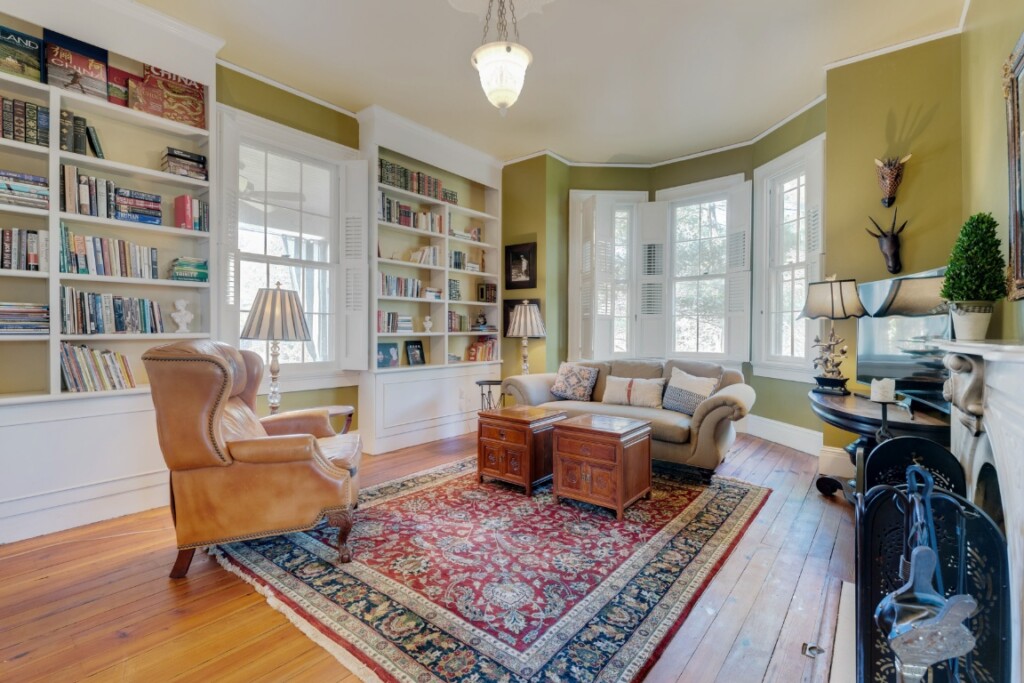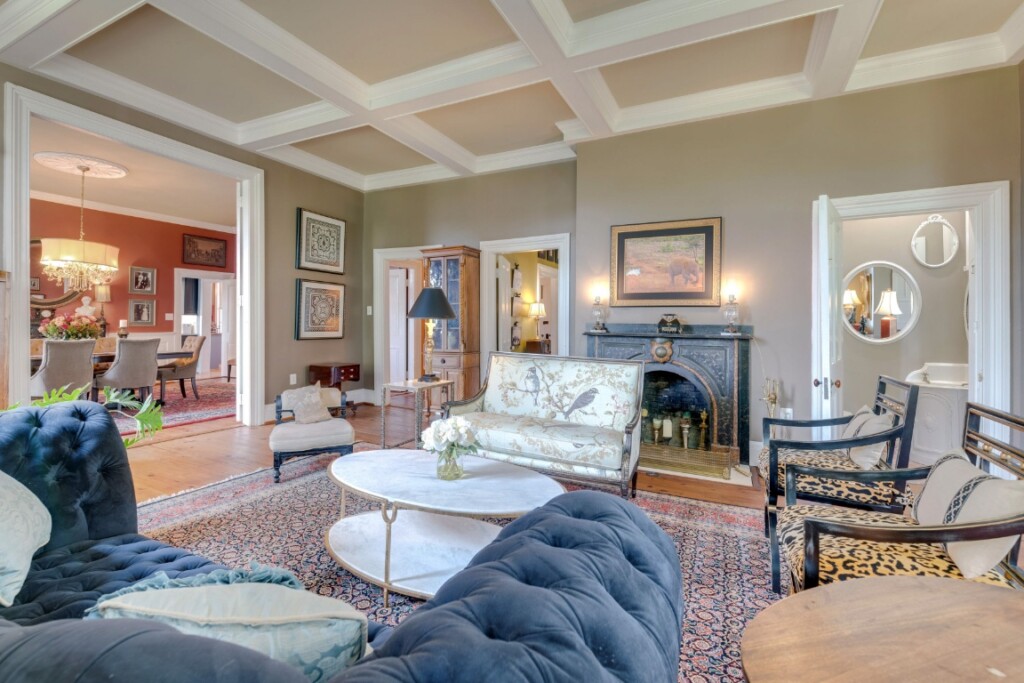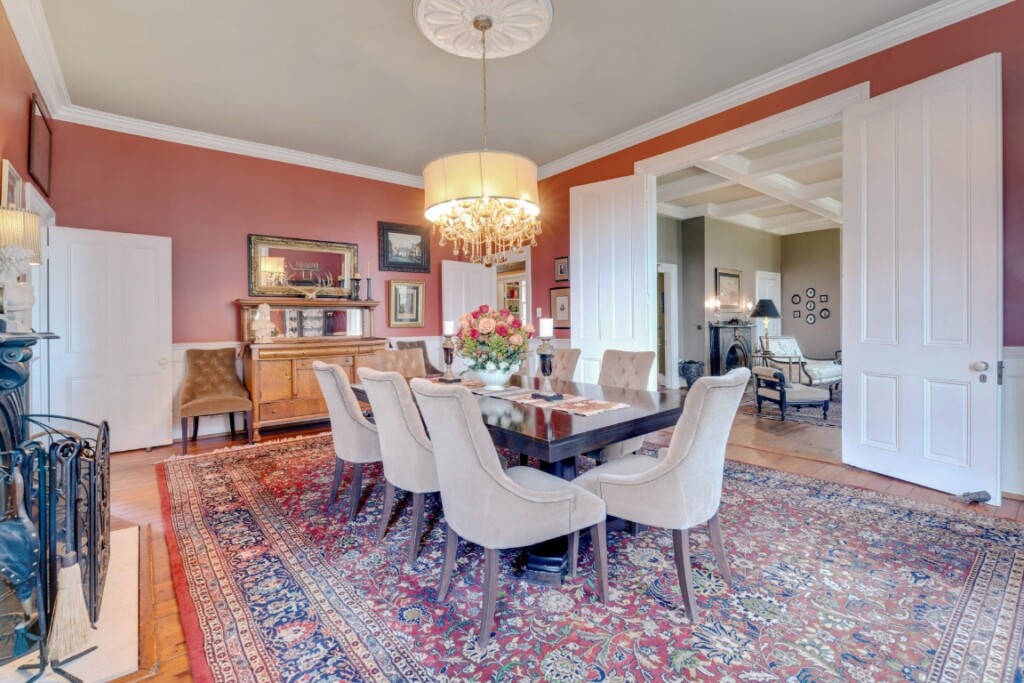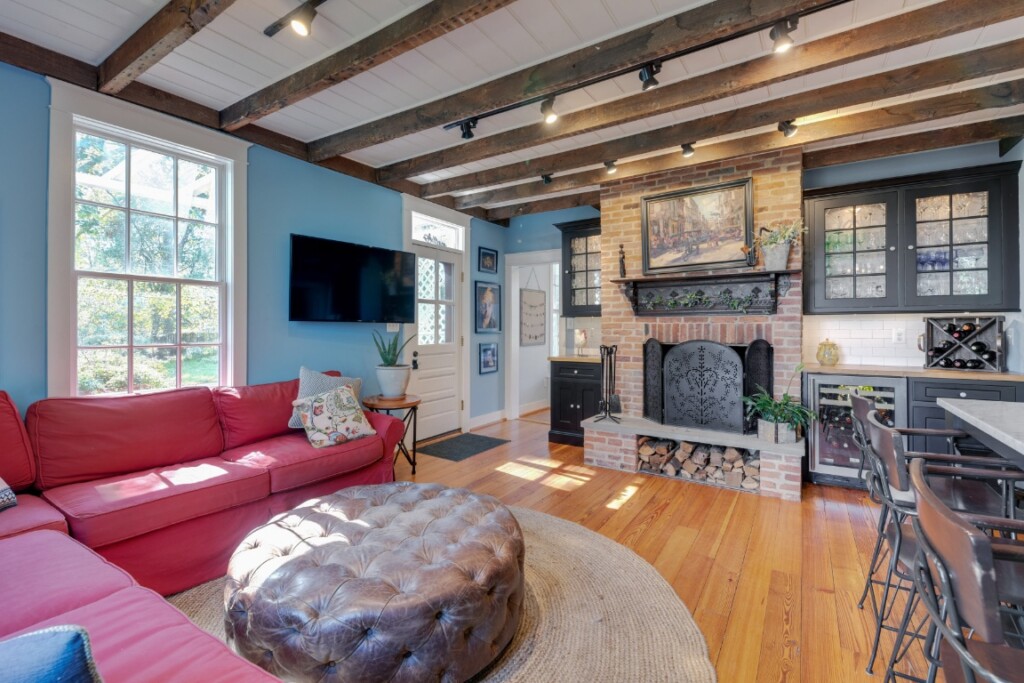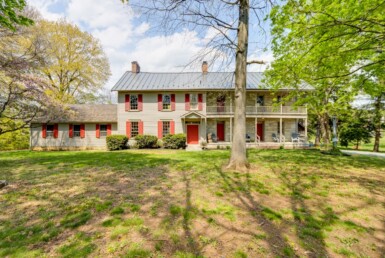MacAlpine Architectural Details From 2004 NRHP Registration Form
FIRST FLOOR
Entry Foyer
The first story has a stair hall in the southwest comer, a room in the northwest comer, and a short passage from the stair hall to two rooms in the northeast and southeast comers. The hyphen has one room and a passage along the west side. The wing at the south end of the hyphen has a room on the east, a room in the southwest comer, and a stair passage in the northwest comer that connects to the passage in the hyphen. The stair hall flooring is 4 to 5 ‘/2-inch-wide pine that runs north-south. The baseboard has a broken field and a quirked ogee and bevel on top. The architrave has a quirked ogee and bevel back band and a beaded interior edge on the doors but no bead on the window trim. The door architrave is miter cut while the window architrave has only the back band mitered and the field varies in how it meets at the comers. There is a cast iron heating register in the floor on the center of the east wall. The register has a low relief lozenge pattern of decoration on each side, at the edges. There is no manufacturer’s name on the grate.
There is a three-run stair that ascends to the south on the west wall, with a landing in the southwest comer, and then ascends along the south wall, to the east, and along the east wall, to the north. It has a large turned, tapered newel that appears to be walnut, and a moulded handrail.
There are turned balusters of oak. The stair has an open stringer with jig-sawn brackets and the stair cuts through the middle of the west and south windows. The front, or west, door has double doors with two panels each that have sunken fields and quirked ogee and bevel panel moulds. A new mortise lock replaces an earlier mortise lock. There are flush iron slide bolts at the top and bottom of the door. Each door is hung on plain cast iron butt hinges with two knuckles. There is a four-light transom with ovolo-profile muntins. The sash is mortised-and-tenoned-and-pegged and it pivots open. The west window has 12-inch by 18-inch lights with narrow ovolo muntins, parting beads, and spring latches at the top and bottom. There are also pulleys for sash weights.
The window had shutters on the top but only the hinge mortises remain. The bottom shutters have two leaves to each half of the pair, with two panels on the outer leaves and one adjustable louver over one panel on the inner leaves. The bottom shutters are not hinged because the stairs block them. The shutter panels are sunken and flat, with quirked ogee and bevel panel moulds.
The stair risers and treads are coped around the shutter rails and stiles, as well as the window architrave. The top half of the south window is blocked off by the stair and the plaster wall above. The bottom half matches the west window and is hung on sash cords. It has two typical two-leaf shutters that are mortised-and-tenoned-and-pegged and are hung on plain cast iron butt hinges with three knuckles and fast joints. Below the sash is a jib with two one-panel doors with sunk fields and quirked ogee and bevel panel moulds. There is a slide bolt on the bottom of the east door. The doors are hung on cast iron butt hinges with five knuckles and fast joints, but they are now inoperable. The south door leads to the hyphen passage and has floor panels with sunk fields and quirked ogee and bevel panel moulds on both sides. This is a typical interior door and is hung on plain cast iron butt hinges with two knuckles. It has a mortise lock with porcelain knobs and a slide bolt at the top of the door on the stair side. The door has through tenons but no pegs. There are plaster walls and ceiling and a narrow wood cornice moulding that was probably added in the early 20″‘ century. It has a toms moulding at the top, one reed, and a cavetto at the bottom. It is face-nailed with what appears to be wire nails.
Front Parlor
The northwest room has the same flooring, baseboard, architrave, and cornice moulding as the stair hall. There is a typical door on the south, but the lock is missing. The west window is also typical but the sash is hung on chains and there are new shutters. There is a bay window on the north elevation and the flooring continues uninterrupted into the bay. The sash have 12-inch by 18-inch lights with typical details, are hung on chains, and have new shutters. There is an Adamesque plaster ceiling medallion with low relief of bell flowers with swags in a six-lobed ring, with a fan motif inside the ring and a row of leaves inside that. In the center of the east elevation is a fireplace with splayed jambs of firebrick and a white marble hearth. The bottom of the firebox has a flat iron door that pivots on center pins. Just west of the hearth is a square iron plate with a circular recess in it, but a knob that was clearly here is missing. The fireplace has a white marble mantel that is semicircular-arched, and has low relief carving of apples, pears, and leaves in the spandrels and a cartouche with fruit and leaves in the center. The shelf is scalloped. The mantel extends beyond the hearth into the wood trim on both sides and goes beyond this trim as the mantel steps back. The south side of the chimneybreast has a call bell crank made of brass with a white porcelain knob. The door on the east is typical and there is an old heating grate on the south wall, east of the door, that matches the grate in the stair hall.
Rear Parlor
The northeast room has typical flooring, baseboard, and architrave. There is a new cornice installed in sections, with the joints clearly visible between each section. The cornice has an egg and dart moulding with rosettes in a frieze below it. There is also a plaster ceiling medallion that has a solid center leaving no place to hang a chandelier. The irmer ring has acanthus leaves, then large lobed leaves, and a bead and reel on the outer ring. The medallion is fairly flat and very Greek Revival in character. There is a fireplace on the west elevation with a firebox of firebrick and a white marble hearth. Just east of the hearth is a metal plate in the floor with a knob and the words “DRAFT DAM?” on the plate. There is a marbleized slate mantel with a semi-circular arched opening. The spandrels have grooves cut in a roughly triangular pattern, there is a center cartouche, and the shelf is scalloped. There are four patterns of marbleizing on this mantel. The mantel aligns with the hearth, but the baseboard is several inches short of the mantel on both sides and the floor has a groove in it here suggesting that this mantel is altered or not original to
this location. There is a typical heating grate on the west elevation between the two doors that are set to the south. There is a door to the north of the fireplace on the west elevation. It was typical, but has a new porcelain knob with flowers on it and has a piece added to the hinge stile to make it fit the opening. The wall has old plaster and is early, if not original. At the north end of the room is a bay window that is identical to the bay in the northwest room, and the floor here is continuous. This bay also has new shutters. The east window, set to the north, matches the west window in the stair hall and has old shutters with adjustable louvers in the top center two panels of the bottom pair and the bottom center two panels of the top pair. The west window set to the south is typical, with old shutters and a typical jib below. The south side of the chimneybreast has a call bell crank that matches that of the northwest room, and is typical. On the south elevation are large double doors with four typical panels on each, but the panels are larger. The doors are hung on three typical hinges each and have a mortise lock that is stamped with “RUSSELL & ERWIN MFG. CO.” on the bolt. All of the locks have single keyed bolts. The side of the lock case is marked “R & E MFG.CO. PAT. MAY 29 1866.” To the north of the fireplace in the northeast room is a small powder room with a new marble tile floor and a wall built in on the south that has a vent opening at the top. The west wall has sawn lath. The window on the north has an ogee and bevel back band without the fillet and has a plain inner edge. There is a stained glass casement that has been added inside of the one-over-one sash, and there is a matching stained glass window added to the ceiling. In the comer is a quarter-round cast iron sink with a splash back and cast iron cabinet below the sink. The cabinet has a semicircular-arched door and a panel to each side. Inside of the door it is labeled “J. L. MOTT IRON WORKS 264 & 266 WATER ST, N. Y.” At the west end of the cabinet are threecut outs apparently for pipes, but they are not now being used even though the sink still operates.
Dining Room
The southeast room has typical flooring, baseboard, and architrave. The cornice and ceiling medallion match those of the northeast room. The east window is typical, is hung on chains, has old shutters, and has a typical jib below it. The sash window is also typical, with chains and old shutters. In the center of the south elevation is a fireplace that is flush with the wall and has a firebox of firebrick. There is a white marble hearth and a black marbleized slate mantel with bolection-moulded spandrels and a scroll cartouche. The opening is semicircular arched and the mantelshelf is scalloped. The bottom of the firebox has a pivoting plate. Well north of the hearth is a metal plate in the floor that is missing the knob. The plate is square, with a square indentation in it. The hole for the knob is in the upper left-hand comer and the lower right hand corner is curved. At the bottom of the plate is the word “DRAFT” and on the right side the word “DAMPER.” On the left is the word “OPEN” and at the top of the plate the word “SHUT.” There is a door west of the fireplace that is typical, and the top architrave has the bead cut out for a slide bolt catch. The door on the north elevation, which leads to the passage, is typical but is missing its lock. To the east of this door is a typical heating grate in the floor.
Kitchen
The east room in the hyphen has 4-inch to 6-inch wide pine flooring that runs east-west, with 2 ‘/i-inch pine flooring to the north and short sections of this along much of the west wall. The east windows are typical six-over-six mortised-and-tenoned-and-pegged sash with parting beads, sash chains, and spring latches. They have plain mitered trim. Between the windows is the ghost on the plaster wall of what appears to have been a partition wall running east-west, with what appears to be the ghost of a kitchen dresser that stood against the south side of this wall. The floor has a pattern of nail holes running east-west and set 24 inches apart where this wall was. Much of the east and south walls have been patched with sheet rock and a wood cove cornice has been added to the room. The baseboard is plain. The south wall has the ghost of two openings that are patched with hard, newer plaster. Because the bottom half of the walls is patched it is not possible to determine whether these were windows or doors with transoms. There is a door now in the center of this wall, in part of the ghost of one of these openings, but the door is missing. The architrave here has a beaded interior edge and is mitered. To the west of the door is a built-in closet. The west wall has newer hard plaster on the north half, and there is a door in the north half that has four panels but is shorter and narrower than the typical interior doors. The panels are the same and the moldings are similar but slightly different. The architrave on this door matches that of the south door in this room. This door has a cast iron rim lock with a mineral knob and is marked “R & E.” There is a sUde bolt just above the lock, and the door has plain cast iron butt hinges with five knuckles and fast joints. The floor in this area is patched heavily with 2 Vi-inch-wide pine. The center of the north wall is the back of the fireplace in the southeast room and is at least partly plastered with hard newer plaster at the bottom. The fireplace back projects into this room, with a closet to the east that has a four-panel door that matches the west door. It has the same architrave, but no lock. It originally had a small cabinet lock. There are new shelves in the closet and the original shelves were pulled out and patched over at some point. To the west of the fireplace breast is the remains of a closet that had shelves on top and has beaded-edge boards on the north wall. These boards are deteriorated and split, with some pieces missing. The ceiling in this room has sheet rock.
Sitting Area
The east room in the wing has had the lath and plaster removed from the ceiling. The second story joists are circular-sawn, are 2-1/2 inches to 2-3/4 inches wide by 9-1/4 inches to 10 inches deep, and are spaced 23 inches to 26 inches on centers. There is bridging fastened with cut nails between the joists. The flooring above is 3 inches to 4-1/2 inches wide, is sash-sawn, and runs east-west. The walls in this room have beaded-edge, vertical-board, half wainscot and the floor is 2-1/2 inch wide pine that runs north-south. The south window is a typical six-over-six sash with 10-inch by 16-inch lights. It is mortised-and-tenoned-and-pegged, has spring latches, and has parting beads. There is plain trim with plain comer blocks. The east window is a new wood six-over-six sash. The north door has beaded-interior-edge trim that is mitered at the comers. In the center of the west elevation is a brick chimney that has been greatly altered to make a fireplace. The plaster has been removed and the brick re-pointed, and the east face has been rebuilt with old brick. The opening is 5 feet, 6 inches high, and is segmentally arched with an iron lintel. The center of the fireplace has old brick in the hearth, with the outer edge consisting of a concrete patch where it appears that a brick wall was removed. This would appear to have been an enclosed chimney flue originally, though it is not possible to completely understand how this feature has changed.
Side Hallway
The west hyphen passage has a mixture of flooring identical to the hyphen east room, and some of the floorboards continue through under the door threshold. There are at least two areas of patching to the floor. The north and east doors have beaded-interior-edge, mitered trim. The east wall has a hollow wood box standing vertically on the wall almost three feet south of the door. The box is open on the top less than two feet below the ceiling where there is a 10 inchwide board on the wall running horizontally from this box to the south. The board has a beaded bottom edge and patches along it. The bottom of this wall, south of the box, has beaded-edge, vertical-board half wainscot. On the south is a diagonal wall of sheet rock added to close off the passage. The passage connects to a two-run stair in the northwest comer of the wing. The stair has a turned, tapered newel post similar to the main staircase but smaller and simpler. There are round, tapered balusters and the handrail is ramped at the landing newel. The stair has a plain open stringer and has been closed off with sheet rock between the two flights on the first story. At the second story the stair is enclosed with beaded-edge, vertical boards. The west window matches the east windows in the hyphen east room, but has 10-inch by 16-inch lights. The sash is mortised-and-tenoned-and-pegged, with both spring latches and sash cords, has plain mitered trim, and has new shutters. The west door has beaded-interior-edge architrave that is side cut, with plain trim added on the face of most of it. The door has a cast iron rim lock with a mineral knob, and is labeled “R & E MFG. CO. PAT. MAY 29 1866.” It appears that there was a slide bolt above the lock and one below it once. There is no evidence of any other lock on this door. The three-light transom is mortised-and-tenoned-and-pegged and is held in place with pivots.
Mud Room
The southwest wing room, which is west of the kitchen, has random-width pine flooring that runs east-west and is 3 inches to 4 Y2 inches wide. The door architrave has a beaded interior edge and comer blocks. The window architrave is plain and also has plain comer blocks. The sash
has 10-inch by 16-inch lights, ovolo muntins, and is mortised-and-tenoned-and-pegged. The sash have parting beads and spring latches, and are hung on chains. There is a stairway to the cellar beneath the stairway to the second story, with a vertical-board door closing off the stairs at the landing on the west end.
more>>>



